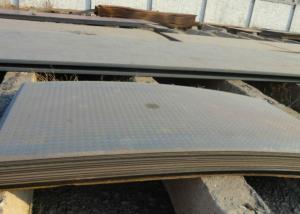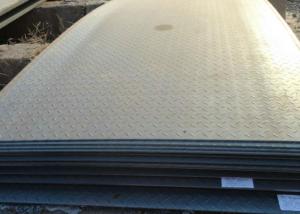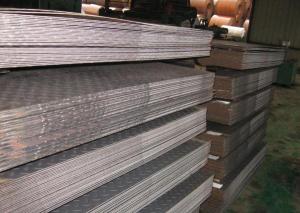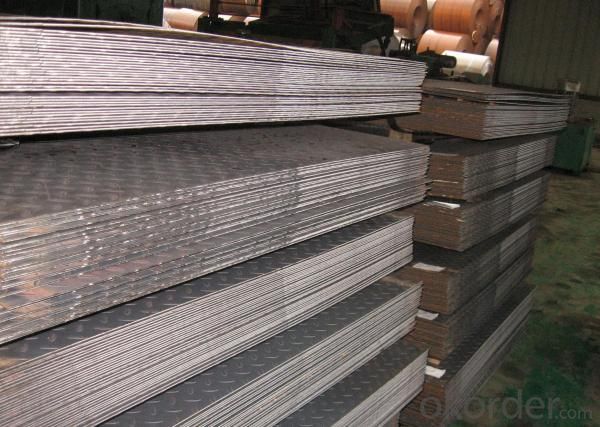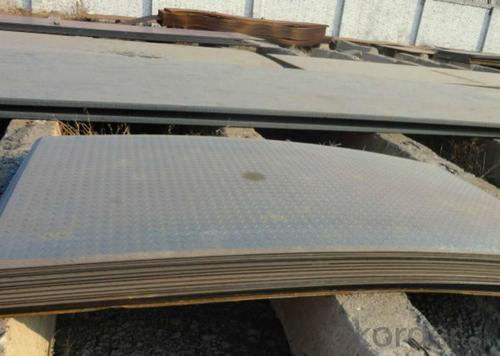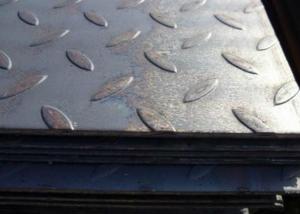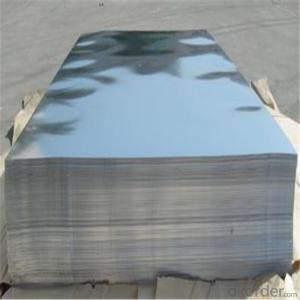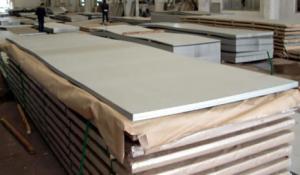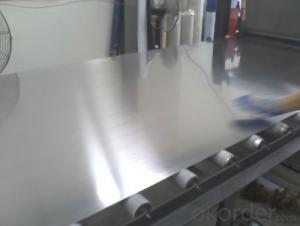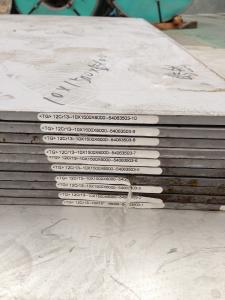Hot Rolled Dimond Plate
- Loading Port:
- Xingang Port
- Payment Terms:
- TT or LC
- Min Order Qty:
- 100MT m.t.
- Supply Capability:
- 10000MT/Year m.t./month
OKorder Service Pledge
OKorder Financial Service
You Might Also Like
Specification of Hot Rolled Dimond Plate:
1.Advantages of our High Quality Hot Rolled Dimond Plate:
Our production capacity is extremly high, just as we take every details in producing and processing under strict control. For example, we have very high final rolling temperature, and meanwhile, the frizzling temperature must be kept suitable, so that the pattern cannot be made collapsed. That’s the reasons for our dimond plate of high quality. The advantages of our dimond plate could be read:
a) The unfairness of our checkered dimond plate: ≤10mm/mtr
b) The surface of our hot rolled checkered dimond plate is free from bubble, scab, crack, fold, edge delamination and so on.
c) The height of our hot rolled dimond plate will be maintained between 0.2~0.3 times to thickness of steel substrate, but more than 0.5mm at least.
2. Other details of Hot Rolled Dimond Plate(Q 345 D as example)
Standard | GB T 3277 |
Grade | Q345 D |
Thickness | 2.5-8.0mm |
Width | 1000-1600mm |
Length | 4000-8000mm |
Note: Dimension of our hot rolled dimond plate can be made according to your requirements, we can futher discuss it.
3. The regular sections we provide are shown in the below table:
Base Thickness(MM) | Allowed Tolerance of Base Thickness(%) | Theoretical Mass (KG/M²) | ||
The Pattern | ||||
Rhombus | Beam | Pea | ||
2.5 | ±0.3 | 21.6 | 21.3 | 21.1 |
3.0 | ±0.3 | 25.6 | 24.4 | 24.3 |
3.5 | ±0.3 | 29.5 | 28.4 | 28.3 |
4.0 | ±0.4 | 33.4 | 32.4 | 32.3 |
4.5 | ±0.4 | 37.3 | 36.4 | 36.2 |
5.0 | 0.4~-0.5 | 42.3 | 40.5 | 40.2 |
5.5 | 0.4~-0.5 | 46.2 | 44.3 | 44.1 |
6.0 | 0.5~-0.6 | 50.1 | 48.4 | 48.1 |
7.0 | 0.6~-0.7 | 59.0 | 52.5 | 52.4 |
8.0 | 0.7~-0.8 | 66.8 | 56.4 | 56.2 |
4. Chemical Composition of Hot Rolled Dimond Plate:
Grade | Chemical Composition | ||||
Q345D | C | Si | Mn | P | S |
≤0.20 | ≤0.55 | 1.00-1.60 | ≤0.035 | ≤0.035 | |
Note: Here, Q345D as example. We are also able to provide SGS test report for checkered steel sheet as per other material grade.
Applications of Hot Rolled Dimond Plate:
1.Definition: The hot rolled dimond plate with raised pattern on surface. The raised pattern could be shaped as rhombus,bean or pea. There is not only one kind of pattern on the checkered steel sheet, but also a complex of two or more than two kinds of pattern on surface of one checkered steel sheet. It also could be called as grid steel sheet.
2.Character: The Hot Rolled Dimond Plate possesses a variet of advantages, such as beauty in appearance,skip resistance and saving steel material.Generally speaking,in order to test the mechanical property or the quality of hot rolled dimond plate, the shaping rate and the pattern height should be tested primarily.
3. In conclusion, the hot rolled dimond plate can usually be used in the industry of ship-building,boiler,automobil,tractor,train- building and architecture. In details, there are many demands for hot rolled dimond plate to make floor,ladder at workshop,work frame pedal,ship deck,car floor and so on.
Package & Delivery of Hot Rolled Dimond Plate:
1. The items to be prepared for packing include: narrow steel strip, crude steel belt or edge angle steel, kraft paper or galvanized sheet.
2. The hot rolled dimond plate should be wrapped with kraft paper or galvanized sheet ouside, and it should be bundled with narrow steel strip, three or two narrow steel strip in longitudinal direction,and the other three or two strips in transverse direction. Furthermore, in order to fix the hot rolled checkered steel plate and avoid the strip at edge shall be broken, the crude steel belt cut into square should be put under the narrow steel strip on the edge. Of course, the hot rolled checkered steel plate could be bundled without kraft paper or galvanized sheet. It depends on customer’s requirement.
3. In consideration of the transportaion from mill to loading port, the truck will be usually used. And the maximum quantity for each truck is 40mt.
4. All in all, we could do in accordance with customer's request.
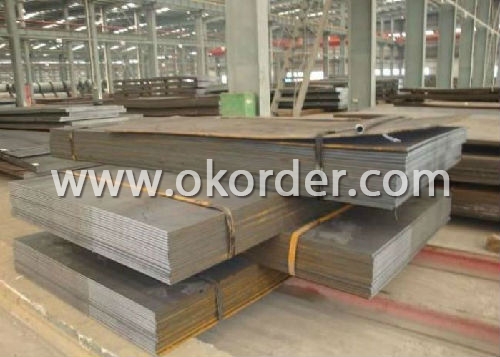

- Q: Can steel sheets be used for conveyor belts?
- Yes, steel sheets can be used for conveyor belts. Steel is a versatile and durable material that can withstand heavy loads and high temperatures, making it suitable for conveyor belt applications. Steel sheets can be fabricated into various shapes and sizes, allowing for customization based on the specific conveyor system requirements. Additionally, steel sheets offer excellent resistance to wear, impact, and corrosion, ensuring a longer lifespan for the conveyor belt. Overall, steel sheets provide a reliable and robust solution for conveyor belt applications in industries such as manufacturing, mining, and logistics.
- Q: What are the different packaging options for steel sheets?
- Some of the different packaging options for steel sheets include bundles, coils, pallets, and crates. Bundles are typically used for smaller sheets and consist of multiple sheets stacked together and secured with metal straps. Coils are used for larger sheets and are wound into a cylindrical shape. Pallets are commonly used for transportation and storage, where steel sheets are placed on top of a wooden or plastic pallet and secured with straps or stretch film. Crates are wooden or metal containers that provide additional protection for steel sheets during transportation and can be customized to fit specific sheet sizes and quantities.
- Q: Are steel sheets prone to warping or bending over time?
- Steel sheets are generally not prone to warping or bending over time due to their high strength and durability. However, factors such as excessive heat or improper handling can potentially cause distortion or deformation in steel sheets.
- Q: What are the standard tolerances for steel sheets?
- The standard tolerances for steel sheets vary depending on factors such as thickness, width, length, and type of steel. However, typical tolerances for steel sheets range from +/- 0.005 inches to +/- 0.030 inches, or +/- 0.13 millimeters to +/- 0.76 millimeters. It's important to note that specific industries and applications may have tighter or looser tolerances based on their requirements.
- Q: Can steel sheets be used for food-grade applications?
- Yes, steel sheets can be used for food-grade applications. However, it is crucial to ensure that the steel sheets are made from food-grade stainless steel, such as Type 304 or Type 316, which comply with specific sanitary regulations and have excellent corrosion resistance properties. Additionally, proper cleaning and maintenance practices must be followed to ensure the safety and hygiene of the food contact surfaces.
- Q: Can steel sheets be used for food processing applications?
- Yes, steel sheets can be used for food processing applications. Steel is a durable and hygienic material that can withstand high temperatures and harsh cleaning processes. It is commonly used for food processing equipment, such as work surfaces, countertops, and food storage containers.
- Q: Can steel sheets be used for structural purposes?
- Yes, steel sheets can be used for structural purposes. Steel is a strong and durable material, and when formed into sheets, it can provide structural support in various applications such as building construction, bridges, and automotive manufacturing. The versatility of steel sheets allows for customization and ease of installation, making them a popular choice for structural purposes.
- Q: What is the maximum width of steel sheets?
- The maximum width of steel sheets can vary depending on the manufacturing process and specific requirements, but it is typically around 2.5 meters or 8 feet.
- Q: Is the pattern steel plate hot-dip galvanized steel?
- The checkered steel plate can be used as a floor, a workshop, an escalator, a work stand, a pedal, a ship deck, a car floor, etc. because of its protruding edge and antiskid function. A steel plate used for workshops, large equipment, or walkways and stairways of a ship.
- Q: What are the different fastening options for steel sheets?
- Depending on the specific application and requirements, there are various fastening options available for steel sheets. Some commonly used fastening options for steel sheets include the following: 1. Screws: Steel sheets can be secured using screws, which are easily accessible and simple to use. Self-tapping screws are commonly employed to fasten steel sheets as they can create their own threads in the material. 2. Bolts and nuts: Bolts and nuts offer a robust and secure fastening choice for steel sheets. They are frequently utilized in situations where adjustability or removability is required. 3. Rivets: Rivets are permanent fasteners commonly used to join two or more steel sheets together. They are often preferred in applications where a watertight or airtight seal is necessary. 4. Welding: Welding is a widely used method for fastening steel sheets. It involves melting the edges of the sheets and joining them together. Welding provides a strong and durable connection but necessitates specialized equipment and expertise. 5. Adhesives: Certain adhesives, such as epoxy or structural adhesives, can be used to bond steel sheets together. Adhesives can create a clean and visually appealing connection, although their strength may vary depending on the specific adhesive used. 6. Clips and clamps: Clips and clamps are frequently employed to secure steel sheets in place. They can be easily installed and removed, making them a popular choice for temporary or adjustable fastening requirements. 7. Magnetic fasteners: Magnetic fasteners, such as magnetic strips or magnets with hooks, can be utilized to attach steel sheets to magnetic surfaces. This offers a convenient and user-friendly fastening option. When selecting a fastening option for steel sheets, it is crucial to consider factors such as strength, durability, ease of installation, and removal. Additionally, the specific requirements of the application, including load-bearing capacity and environmental conditions, should be taken into account to ensure the chosen fastening option is suitable for the intended purpose.
1. Manufacturer Overview
| Location | Tianjin, China |
| Year Established | 2004 |
| Annual Output Value | Above US$ 500 Million |
| Main Markets | China; Europe; America; Southeast Asia |
| Company Certifications | ISO9001、ISO14001、OHSAS18001 |
2. Manufacturer Certificates
| a) Certification Name | |
| Range | |
| Reference | |
| Validity Period |
3. Manufacturer Capability
| a) Trade Capacity | |
| Nearest Port | Tianjin; Qingdao; Dalian |
| Export Percentage | 41% - 50% |
| No.of Employees in Trade Department | 21-50 People |
| Language Spoken: | English; Chinese |
| b) Factory Information | |
| Factory Size: | Above 900,000 square meters |
| No. of Production Lines | 3 |
| Contract Manufacturing | OEM Service Offered |
| Product Price Range | High; Average |
Send your message to us
Hot Rolled Dimond Plate
- Loading Port:
- Xingang Port
- Payment Terms:
- TT or LC
- Min Order Qty:
- 100MT m.t.
- Supply Capability:
- 10000MT/Year m.t./month
OKorder Service Pledge
OKorder Financial Service
Similar products
Hot products
Hot Searches
Related keywords
